American Bank Note Company print runs
The American Bank Note Company produced the following notes. They engraved special vignettes of Miguel Ramos Arispe, the driving force behind Federalism in MexicoMiguel Ramos Arizpe was born on 15 February 1775 in Valle de San Nicolás, Coahuila. He was ordained in 1803, after studying in the seminaries of Monterrey and Guadalajara. He taught canon and civil law in the seminary of Monterrey. He was appointed Deputy of Cortes and went to Cadiz in order to attend the Congress of 1812, where he made public his support for the independence of New Spain. Ferdinand VII had him imprisoned for four years because of these ideas. He returned to Mexico in 1822 as President of the Commission of the Constitutional Congress of 1823. His belief in a Federal system of government helped ensure that the newly born Mexican Republic adopted the Federalist system. He died of gangrene on 28 April 1843. and Victoriano Cepeda Camacho, several times governor of CoahuilaVictoriano Cepeda was born in Saltillo, Coahuila in 1826. Being a liberal, he fought against the conservatives. During the Three Year War, he participated in several battles and fought at the head of his guerrilla forces. When the government of Benito Juárez triumphed, Victoriano Cepeda returned to Saltillo where he worked as a tax collector. He later took up arms again during the French Intervention as leader of the First Light Battalion of Coahuila. When it ended and Juárez’ government was established again, Victoriano Cepeda returned to Coahuila to be elected governor of his home state. He died in Villa de Guadalupe, D.F., in 1892. (C 219).
Incidentally, a San Luis Potosí newspaper, reporting on the notes that were expected in Saltillo shortly, said that they would have the busts of Zepeda and Ramos Arizpe on the face and on the reverse views of the principal monuments such as the Cathedral, statue of Zaragoza, etc. together with other scenes from the town or countrysideEl Contemporáneo, San Luis Potosí, Tomo II, Núm. 362, 15 October 1897. Either the newspaper was mistaken or we have a record of the bank’s original proposals.
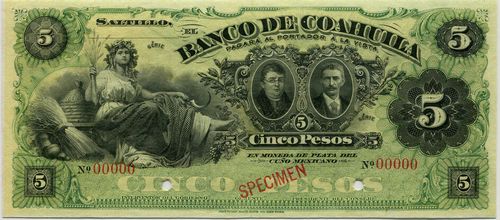
 M167s $5 Banco de Coahuila specimen
M167s $5 Banco de Coahuila specimen
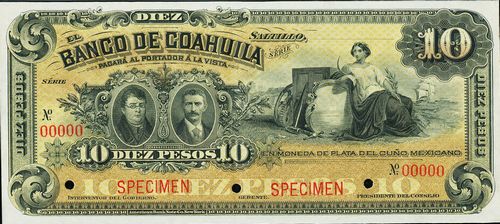
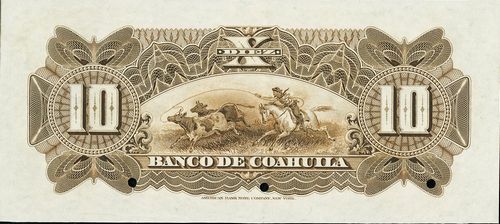 M168s $10 Banco de Coahuila specimen
M168s $10 Banco de Coahuila specimen
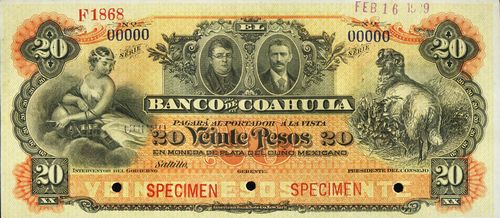
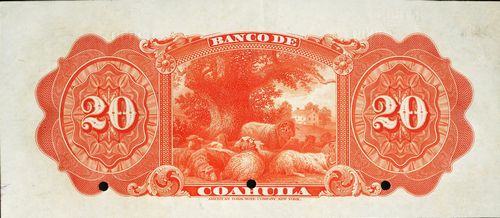 M169s $20 Banco de Coahuila specimen
M169s $20 Banco de Coahuila specimen
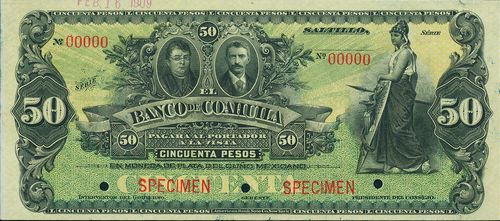
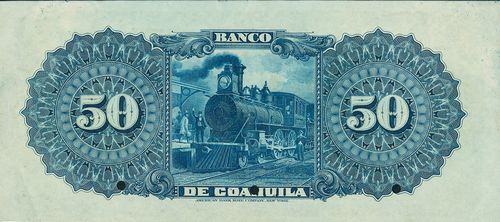 M170s $50 Banco de Coahuila specimen
M170s $50 Banco de Coahuila specimen
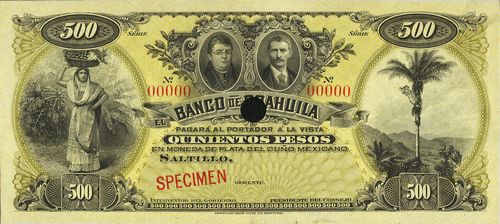
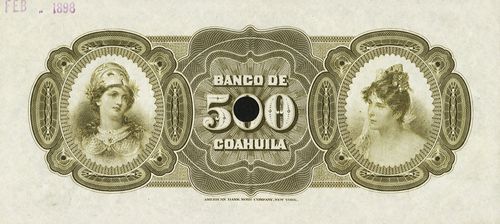 M172s $500 Banco de Coahuila specimen
M172s $500 Banco de Coahuila specimen
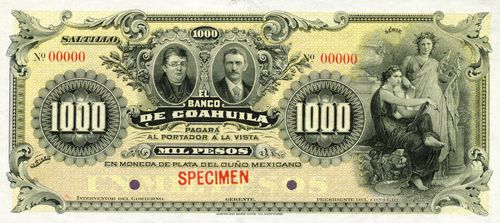
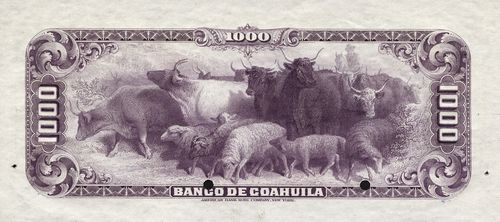 M173s $1.000 Banco de Coahuila specimen
M173s $1.000 Banco de Coahuila specimen
| Date | Value | Number | Series | from | to |
| August 1897 | $5 | 20,000 |
1 | 20000 | |
| $10 | 10,000 |
1 | 10000 | ||
| $20 | 5,000 |
1 | 5000 | ||
| $50 | 3,000 |
1 | 3000 | ||
| $100 | 1,500 |
1 | 1500 | ||
| $500 | 200 |
1 | 200 | ||
| $1000 | 50 |
1 | 50 |
| Date | Value | Number | Series | from | to |
| January 1898 | $5 | 20,000 |
20001 | 40000 | |
| $10 | 10,000 |
10001 | 20000 | ||
| $20 | 5,000 |
5001 | 10000 | ||
| $50 | 3,000 |
3001 | 6000 | ||
| $100 | 1,500 |
1501 | 3000 | ||
| $500 | 200 | 201 | 400 | ||
| $1000 | 50 | 51 | 100 |
| Date | Value | Number | Series | from | to |
| May 1899 | $5 | 20,000 |
40001 | 60000 | |
| $10 | 10,000 |
20001 | 30000 | ||
| $20 | 5,000 |
10001 | 15000 | ||
| $50 | 2,000 |
6001 | 8000 | ||
| $100 | 1,000 |
3001 | 4000 |
| Date | Value | Number | Series | from | to |
| May 1900 | $5 | 40,000 |
60001 | 100000 | |
| $10 | 20,000 |
30001 | 50000 | ||
| $20 | 5,000 |
15001 | 20000 |
The bank ordered another printing on 6 February 1909, with better paper (order F 1868) ABNC, folder 281, Banco de Coahuila (1907-1932).
| Date | Value | Number | Series | from | to |
| February 1909 | $5 | 50,000 |
100001 | 150000 | |
| $10 | 15,000 |
50001 | 65000 | ||
| $20 | 5,000 |
20001 | 25000 | ||
| $50 | 1,000 |
8001 | 9000 | ||
| $100 | 500 |
4001 | 4500 |
The $10, 4,000 $20, $50 and $100 notes were shipped, by Wells Fargo & Co’s Express, on 19 May 1909. The order would have been delivered complete but on a number of impressions the colour was wrong (they did not match) and so these had to be reprinted. The balance of the $20 notes and 18,000 of the $5 notes were shipped on 30 June. The final 32,000 $5 notes were shipped on 9 Julyibid..
The bank ordered another printing (order F 2420) on 2 March 1910, five days later asking the ABNC to replace the title ‘PRESIDENTE DEL CONSEJERO’ with ‘CONSEJERO’.

 M167s $5 Banco de Coahuila specimen
M167s $5 Banco de Coahuila specimen
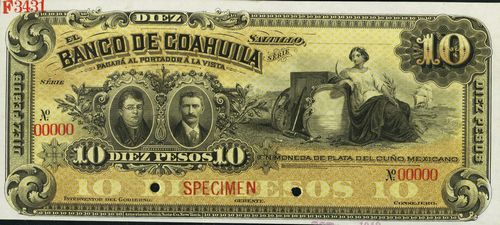
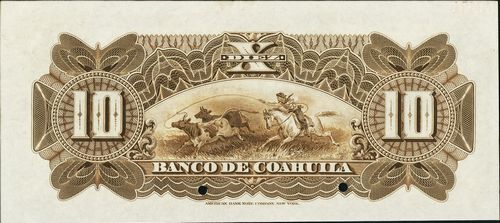 M168s $10 Banco de Coahuila specimen
M168s $10 Banco de Coahuila specimen

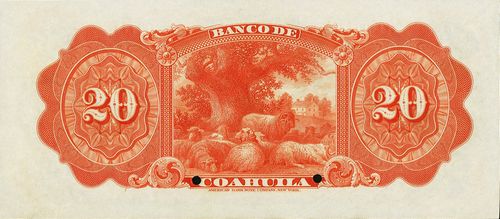 M169s $20 Banco de Coahuila specimen
M169s $20 Banco de Coahuila specimen
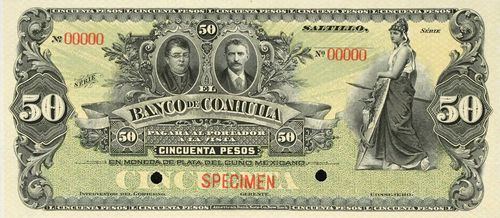
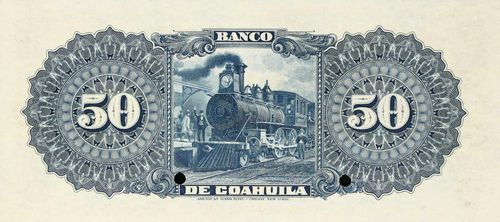 M170s $50 Banco de Coahuila specimen
M170s $50 Banco de Coahuila specimen
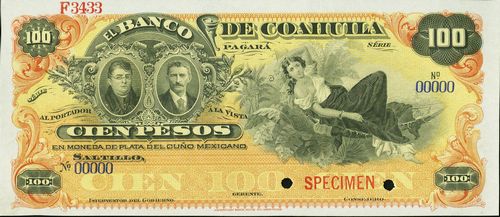
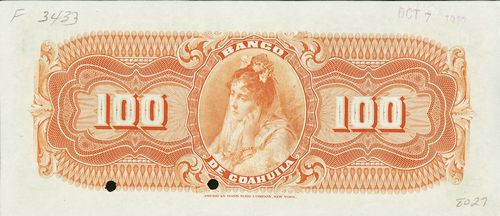 M171s $100 Banco de Coahuila specimen
M171s $100 Banco de Coahuila specimen
| Date | Value | Number | Series | from | to |
| March 1910 | $20 | 2,500 |
25001 | 27500 | |
| $50 | 2,000 |
9001 | 11000 | ||
| $100 | 1,000 |
4501 | 5500 |
These were dispatched on 10 May, by which time the bank was desperate for the new notesibid..
The next printing was ordered (order F 3075) on 10 October 1911.
| Date | Value | Number | Series | from | to |
| October 1911 | $5 | 7,000 |
150001 | 157000 | |
| $10 | 2,000 |
65001 | 67000 | ||
| $20 | 1,000 |
27501 | 28500 | ||
| $50 | 1,000 |
11001 | 12000 | ||
| $100 | 1,000 |
5501 | 6501 |
These were dispatched on 10 February 1912ibid.. On 3 October 1912 the bank ordered another printing (F 3430, 3431, 3432 and 3433).
| Date | Value | Number | Series | from | to |
| October 1912 | $5 | 60,000 |
157001 | 217000 | |
| $10 | 30,000 |
67001 | 97000 | ||
| $20 | 5,000 |
28501 | 33500 | ||
| $50 | 3,000 |
12001 | 15000 | ||
| $100 | 1,500 |
6501 | 8000 |
The ABNC had to produce some new platesthe face, back and tint plates for the $5, and the face plates for the $10 and $20 so this order was not ready until March 1914. The company contacted Wells Fargo who advised them that they could not receive the consignment because there was no train service from Texas to Mexico. However, the notes were shipped on 28 MarchABNC, folder 281, Banco de Coahuila (1907-1932). The final order was requested even before this, on 23 March 1914. The ABNC replied, on 27 March, that as they had found, on examination, that they would have to lay down some new plates, and were extemely, busy, the earliest delivery date they could give would be in six to seven weeks. The bank confirmed its order on 31 March (F 4153 and F 4154)ibid..
| Date | Value | Number | Series | from | to |
| April 1914 | $5 | 100,000 |
217001 | 317000 | |
| $10 | 150,000 |
97001 | 247000 |
By 27 April the ABNC had done some preparatory work on the five pesos, when it was told to stop all work. It was told to begin work again on 4 May. A week later the bank was desperate for notes and asked the ABNC to ship all that it had printed to the Banco Central Mexicano via Veracruz, but by this time there were no steamers sailing from the United States to Mexicoibid..
On 13 June the ABNC despatched, via the S.S. Kotonia, a box containing 21,000 $5 notes (217001 to 238000)ibid..
The bank had temporarily transferred its offices to Mexico City and on 26 June asked the ABNC to suspend all shipments until further notice. By then the printing was almost complete and the ABNC continued to finish the order. The Resident Agent in Mexico City had been trying to get a part payment from the bank but was told in October that nothing could be done until the bank reopened its premises in Saltillo. However, despite efforts, the outstanding balance of $6,283.68 U.S. currency was never paidibid..
The rest of the order ($5 notes 238001 to 317000 and $10 970001 to 247000) remained in the ABNC vaults. On 1 August 1924 the ABNC wrote to Mexico and on 24 October the Resident Agent replied that the bank would make a final decision in February 1925 and asked for the company to hold them until that time. In November 1928 the two parties were still discussing the payment of the debt and disposal of the notes, without a resolutionibid..
The ABNC cancelled the plates used in printing the notes The outstanding plates were:
1 – 1 on 5 Pesos tint #1 (for Litho transfer) made on order 8/27/97
1 – 6 on 5 Pesos tint #2 plate #2 (steel) made on order F 3430
1 – 6 on 5 Pesos face plate #2 made on order F 3430
1 – 6 on 5 Pesos back plate #4 made on order F 4153
2 – 1 on 10 Pesos tint nos. 1 & 2 (for Litho transfer) made on order 8/27/97
2 – 8 on 10 Pesos face plates nos. A4 & A5 made on order F 4154
2 – 8 on 10 Pesos back plates nos. A3 & A4 made on order F 4154
1 – 1 on 20 Pesos tint #1 (for Litho transfer) made on order 8/27/97
1 – 4 on 20 Pesos tint #2 Plate #1 (steel) made on order 8/27/97
1 – 4 on 20 Pesos face plate #2 made on order F 3431
1 – 4 on 20 Pesos back plate #1 made on order 8/27/97
2 – 1 on 50 Pesos tint nos.1 & 2 (for Litho transfer) made on order 8/27/97
1 – 2 on 50 Pesos face plate made on order 8/27/97
1 – 2 on 50 Pesos back plate made on order 8/27/97
2 – 1 on 100 Pesos tint nos.1 & 2 made on order 8/27/97
1 – 2 on 100 Pesos face plate made on order 8/27/97
1 – 2 on 100 Pesos back plate made on order 8/27/97
2 – 1 on 500 Pesos tint nos.1 & 2 made on order 8/27/97
1 – 2 on 500 Pesos face plate made on order 8/27/97
1 – 2 on 500 Pesos back plate made on order 8/27/97
2 – 1 on 1000 Pesos tint nos.1 & 2 made on order 8/27/97
1 – 2 on 1000 Pesos face plate made on order 8/27/97
1 – 2 on 1000 Pesos back plate made on order 8/27/97
(ABNC, folder 281, Banco de Coahuila (1907-1932) on 6 October 1931 (order F 9466)ibid..
The outstanding $5 and $10 9 notes were finally destroyed in March 1933 (order F 9680).
